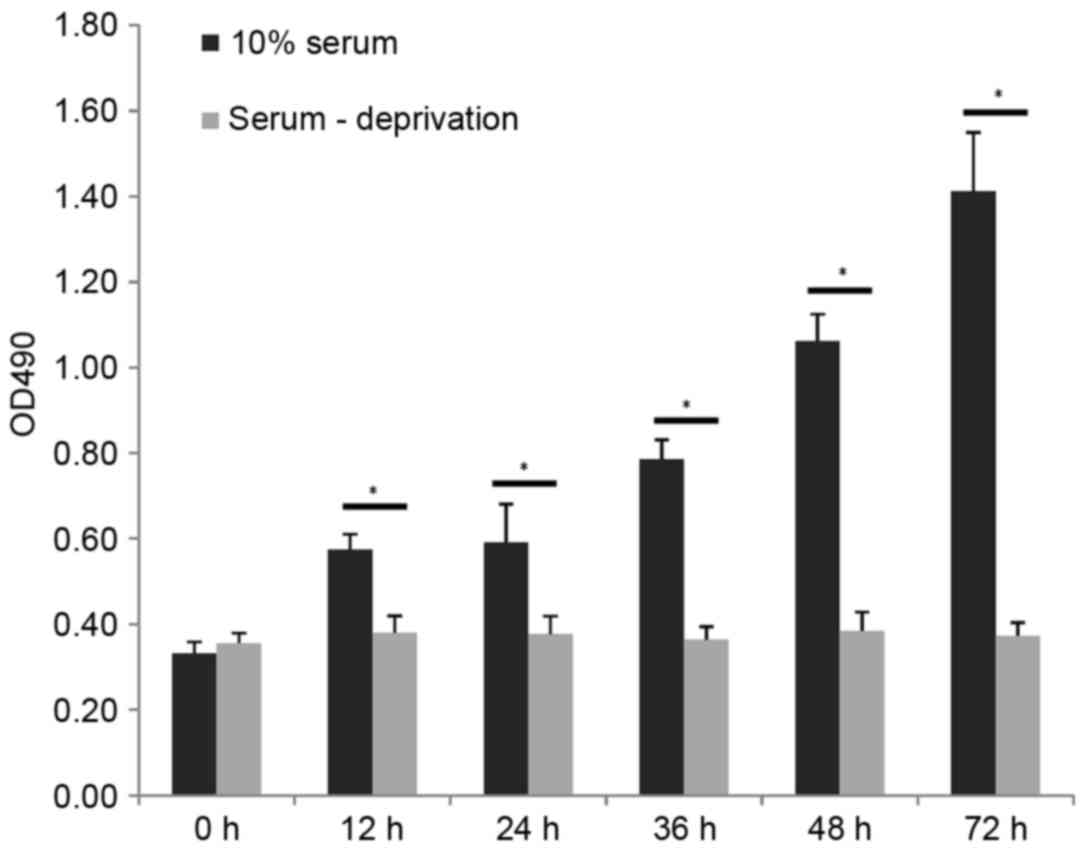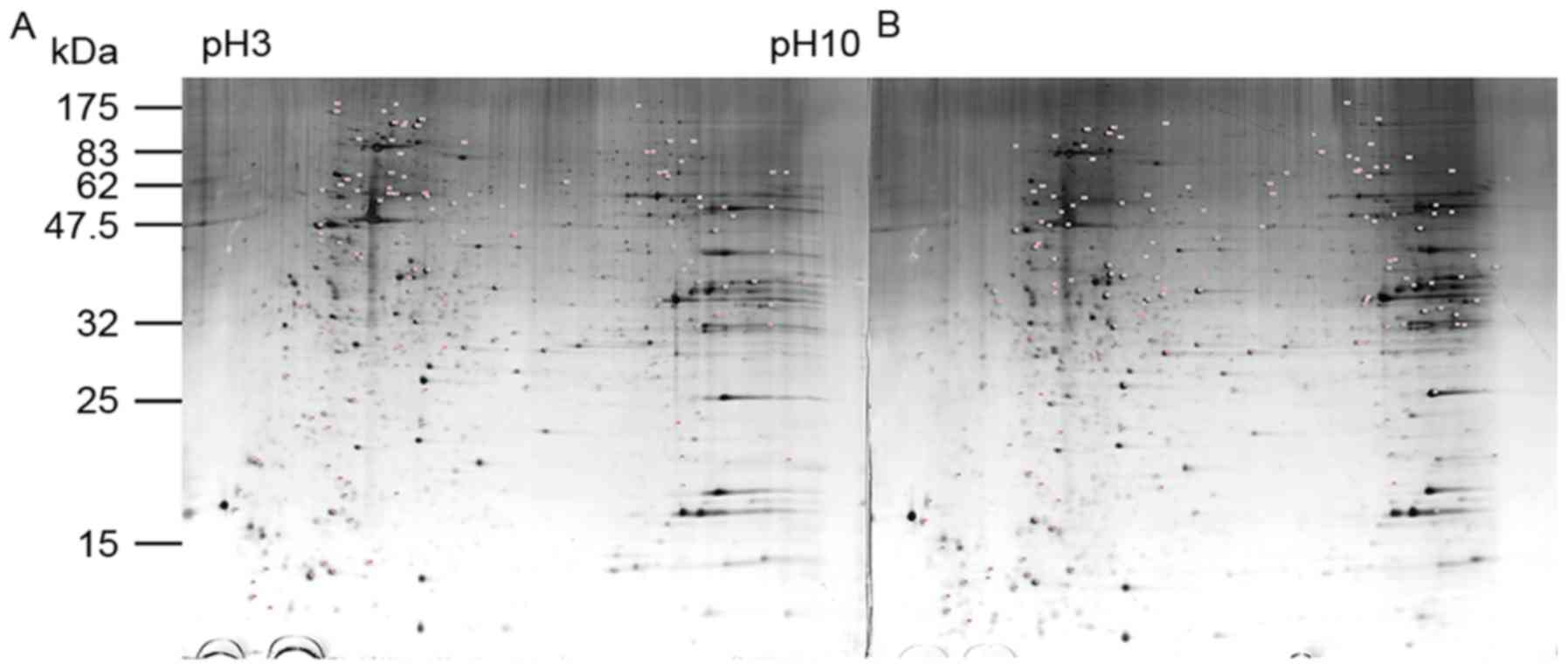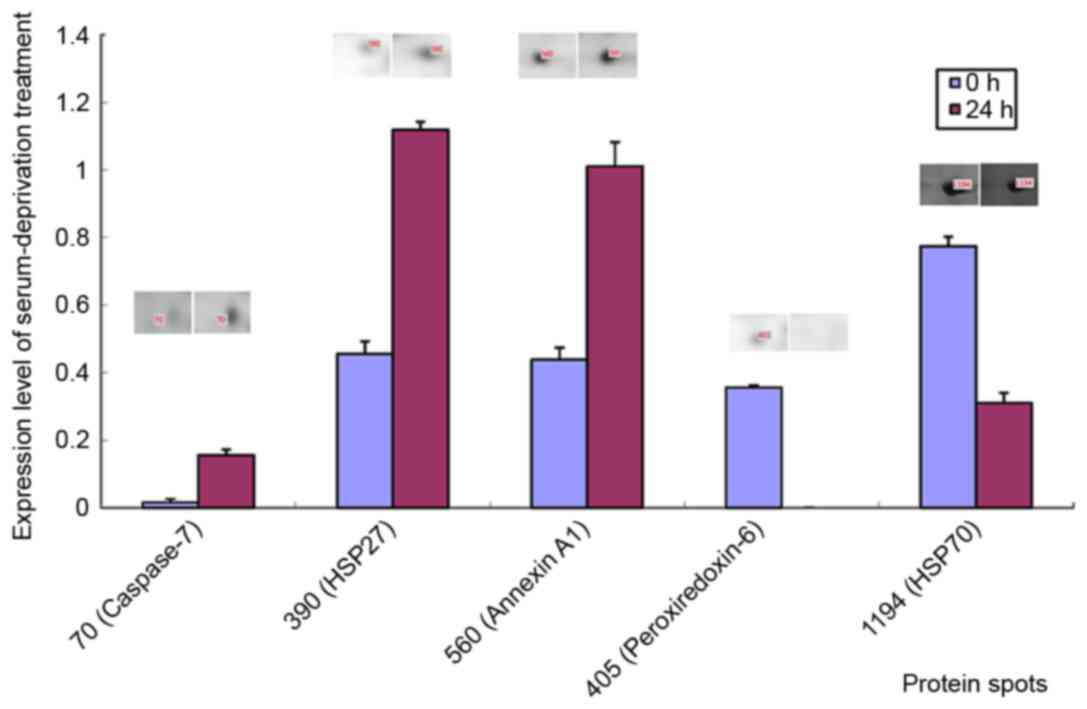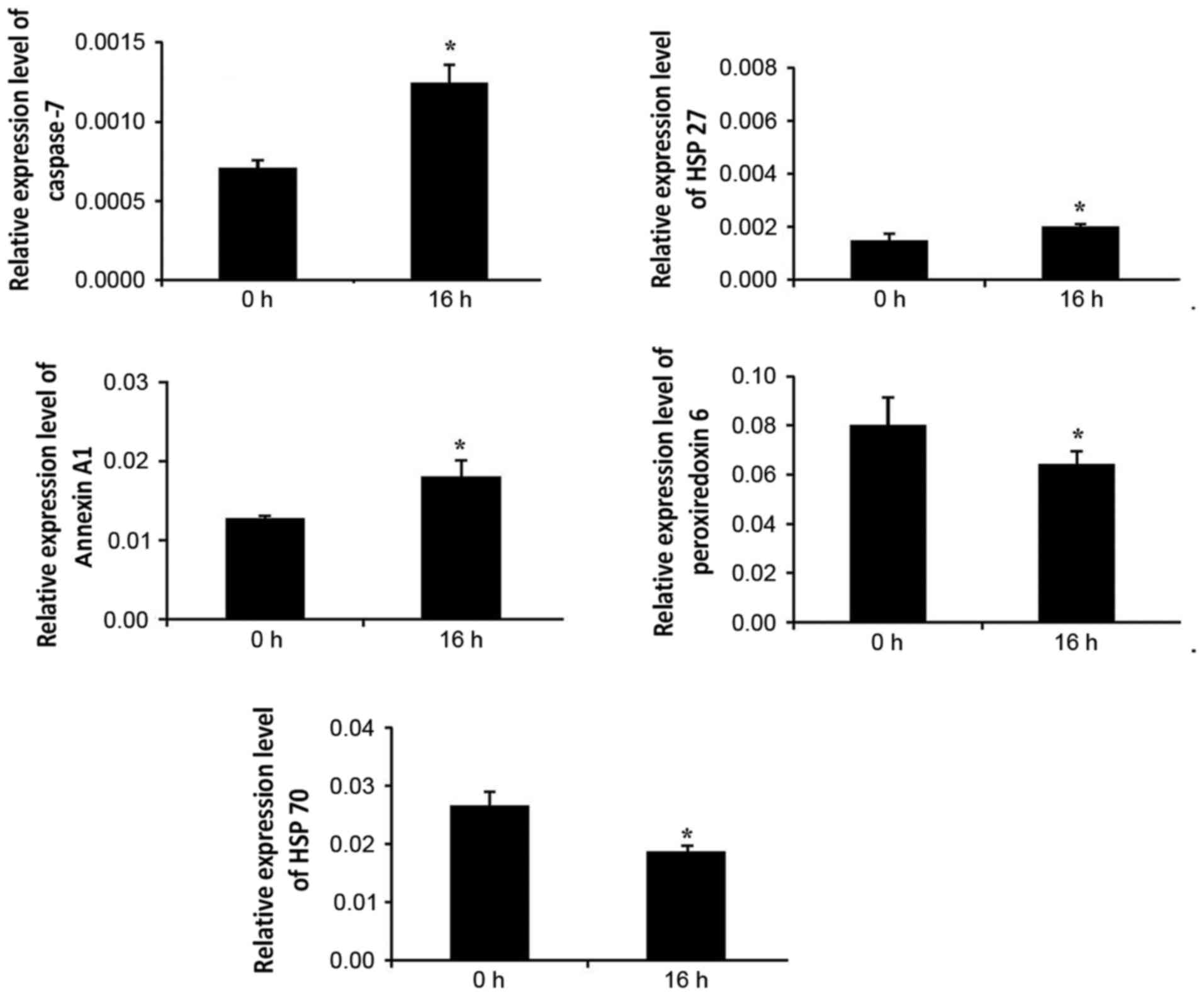|
1
|
Ching CT, Sun TP, Huang SH, Hsiao CS,
Chang CH, Huang SY, Chen YJ, Cheng CS, Shieh HL and Chen CY: A
preliminary study of the use of bioimpedance in the screening of
squamous tongue cancer. Int J Nanomed. 5:213–220. 2010. View Article : Google Scholar
|
|
2
|
Jemal A, Siegel R, Ward E, Hao Y, Xu J and
Thun MJ: Cancer statistics, 2009. CA Cancer J Clin. 59:225–249.
2009. View Article : Google Scholar : PubMed/NCBI
|
|
3
|
Layland MK, Sessions DG and Lenox J: The
influence of lymph node metastasis in the treatment of squamous
cell carcinoma of the oral cavity, oropharynx, larynx, and
hypopharynx: N0 versus N+. Laryngoscope. 115:629–639. 2005.
View Article : Google Scholar : PubMed/NCBI
|
|
4
|
Korostoff A, Reder L, Masood R and Sinha
UK: The role of salivary cytokine biomarkers in tongue cancer
invasion and mortality. Oral Oncol. 4:282–287. 2011. View Article : Google Scholar
|
|
5
|
Faratzis G, Tsiambas E, Rapidis AD,
Machaira A, Xiromeritis K and Patsouris E: VEGF and ki 67
expression in squamous cell carcinoma of the tongue: An
immunohistochemical and computerized image analysis study. Oral
Oncol. 45:584–588. 2009. View Article : Google Scholar : PubMed/NCBI
|
|
6
|
Patel RS, Clark JR, Dirven R, Wyten R, Gao
K and O'Brien CJ: Prognostic factors in the surgical treatment of
patients with oral carcinoma. Anz J Surg. 79:19–22. 2009.
View Article : Google Scholar : PubMed/NCBI
|
|
7
|
Lee SB, Kim JJ, Kim TW, Kim BS, Lee MS and
Yoo YD: Serum deprivation-induced reactive oxygen species
production is mediated by Romo1. Apoptosis. 15:204–218. 2010.
View Article : Google Scholar : PubMed/NCBI
|
|
8
|
Grossman N, Binyamin LA and Bodner L:
Effect of rat salivary glands extracts on the proliferation of
cultured skin cells-a wound healing model. Cell Tissue Bank.
4:205–212. 2004. View Article : Google Scholar
|
|
9
|
De Giuseppe R, Cossellu G, Vigna L,
Dicorato F, De Vita C, Venturelli G, Bamonti F, Maiavacca R and
Farronato G: Correlation between salivary and serum oxidized LDL
levels: A pilot study on overweight/obese subjects. J Oral Pathol
Med. 44:884–887. 2015. View Article : Google Scholar : PubMed/NCBI
|
|
10
|
Hayes LD, Sculthorpe N, Herbert P, Baker
JS, Hullin DA, Kilduff LP and Grace FM: Poor levels of agreement
between serum and saliva testosterone measurement following
exercise training in aging men. Aging Male. 18:67–70. 2015.
View Article : Google Scholar : PubMed/NCBI
|
|
11
|
Seethalakshmi C, Koteeswaran D and
Chiranjeevi V: Correlation of serum and salivary biochemical
parameters in end stage renal disease patients undergoing
hemodialysis in pre and post-dialysis state. J Clin Diagn Res.
12:CC12–CC14. 2014.
|
|
12
|
Boraldi F, Annovi G, Paolinelli-Devincenzi
C, Tiozzo R and Quaglino D: The effect of serum withdrawal on the
protein profile of quiescent human dermal fibroblasts in primary
cell culture. Proteomics. 8:66–82. 2008. View Article : Google Scholar : PubMed/NCBI
|
|
13
|
Li WZ, Wang XY, Li ZG, Zhang JH and Ding
YQ: Celecoxib enhances the inhibitory effect of cisplatin on
Tca8113 cells in human tongue squamous cell carcinoma in vivo and
in vitro. J Oral Pathol Med. 7:579–584. 2010.
|
|
14
|
Wu J, Wang F, Gong Y, Li D, Sha J, Huang X
and Han X: Proteomic analysis of changes induced by nonylphenol in
Sprague-Dawley rat Sertoli cells. Chem Res Toxicol. 22:668–675.
2009. View Article : Google Scholar : PubMed/NCBI
|
|
15
|
Cheuk BL and Cheng SW: Annexin A1
expression in atherosclerotic carotid plaques and its relationship
with plaque characteristics. Eur J Vasc Endovasc Surg. 41:364–371.
2011. View Article : Google Scholar : PubMed/NCBI
|
|
16
|
Livak KJ and Schmittgen TD: Analysis of
relative gene expression data using real-time quantitative PCR and
the 2(-Delta Delta C(T)) method. Methods. 25:402–408. 2001.
View Article : Google Scholar : PubMed/NCBI
|
|
17
|
Yuan F, Cheng Q, Li G and Tong T:
Nucleostemin knockdown sensitizes hepatocellular carcinoma cells to
ultraviolet and serum starvation-induced apoptosis. PLoS One.
10:e01416782015. View Article : Google Scholar : PubMed/NCBI
|
|
18
|
Takeda K, Akagi S, Takahashi S, Onishi A,
Hanada H and Pinkert CA: Mitochondrial activity in response to
serum starvation in bovine (Bos taurus) cell culture. Cloning Stem
Cells. 4:223–229. 2002. View Article : Google Scholar : PubMed/NCBI
|
|
19
|
Liu J and Du L: PERK pathway is involved
in oxygen-glucose-serum deprivation-induced NF-kB activation via
ROS generation in spinal cord astrocytes. Biochem Biophys Res
Commun. 467:197–203. 2015. View Article : Google Scholar : PubMed/NCBI
|
|
20
|
Gerrits EG, Alkhalaf A, Landman GW, van
Hateren KJ, Groenier KH, Struck J, Schulte J, Gans RO, Bakker SJ,
Kleefstra N and Bilo HJ: Serum peroxiredoxin 4: A marker of
oxidative stress associated with mortality in type 2 diabetes
(ZODIAC-28). PLoS One. 2:e897192014. View Article : Google Scholar
|
|
21
|
Ding Y, Yamada S, Wang KY, Shimajiri S,
Guo X, Tanimoto A, Murata Y, Kitajima S, Watanabe T, Izumi H, et
al: Overexpression of peroxiredoxin 4 protects against high-dose
streptozotocin-induced diabetes by suppressing oxidative stress and
cytokines in transgenic mice. Antioxid Redox Signal. 13:1477–1490.
2010. View Article : Google Scholar : PubMed/NCBI
|
|
22
|
Manta B, Hugo M, Ortiz C, Ferrer-Sueta G,
Trujillo M and Denicola A: The peroxidase and peroxynitrite
reductase activity of human erythrocyte peroxiredoxin 2. Arch
Biochem Biophys. 484:146–154. 2009. View Article : Google Scholar : PubMed/NCBI
|
|
23
|
Martinez A, Peluffo G, Petruk AA, Hugo M,
Piñeyro D, Demicheli V, Moreno DM, Lima A, Batthyány C, Durán R, et
al: Structural and molecular basis of the peroxynitrite-mediated
nitration and inactivation of trypanosoma cruzi iron-superoxide
dismutases (Fe-SODs) A and B: Disparate susceptibilities due to the
repair of Tyr35 radical by Cys83 in Fe-SODB through intramolecular
electron transfer. J Biol Chem. 289:12760–12778. 2014. View Article : Google Scholar : PubMed/NCBI
|
|
24
|
Cerda MB, Lloyd R, Batalla M, Giannoni F,
Casal M and Policastro L: Silencing peroxiredoxin-2 sensitizes
human colorectal cancer cells to ionizing radiation and
oxaliplatin. Cancer Lett. 388:312–319. 2017. View Article : Google Scholar : PubMed/NCBI
|
|
25
|
Rostila A, Puustinen A, Toljamo T, Vuopala
K, Lindström I, Nyman TA, Oksa P, Vehmas T and Anttila SL:
Peroxiredoxins and tropomyosins as plasma biomarkers for lung
cancer and asbestos exposure. Lung Cancer. 77:450–459. 2012.
View Article : Google Scholar : PubMed/NCBI
|
|
26
|
Shiota M, Yokomizo A, Kashiwagi E,
Takeuchi A, Fujimoto N, Uchiumi T and Naito S: Peroxiredoxin 2 in
the nucleus and cytoplasm distinctly regulates androgen receptor
activity in prostate cancer cells. Free Radic Biol Med. 51:78–87.
2011. View Article : Google Scholar : PubMed/NCBI
|
|
27
|
Zhang B, Wang Y and Su Y: Peroxiredoxins,
a novel target in cancer radiotherapy. Cancer Lett. 286:154–160.
2009. View Article : Google Scholar : PubMed/NCBI
|
|
28
|
Kwon T, Jin KR, Lee JC, Park YH, Shin HJ,
Cho S, Kang YK, Kim BY, Yoon DY and Yu DY: An important role for
peroxiredoxin II in survival of A549 lung cancer cells resistant to
gefitinib. Exp Mol Med. 47:e1652015. View Article : Google Scholar : PubMed/NCBI
|
|
29
|
Sobral-Leite M, Wesseling J, Smit VT,
Nevanlinna H, van Miltenburg MH, Sanders J, Hofland I, Blows FM,
Coulson P and Patrycja G: Annexin A1 expression in a pooled breast
cancer series: association with tumor subtypes and prognosis. BMC
Med. 13:1562015. View Article : Google Scholar : PubMed/NCBI
|
|
30
|
Lin CY, Jeng YM, Chou HY, Hsu HC, Yuan RH,
Chiang CP and Kuo MY: Nuclear localization of annexin A1 is a
prognostic factor in oral squamous cell carcinoma. J Surg Oncol.
97:544–550. 2008. View Article : Google Scholar : PubMed/NCBI
|
|
31
|
Faria PC, Sena AA, Nascimento R, Carvalho
WJ, Loyola AM, Silva SJ, Durighetto AF, Oliveira AD, Oliani SM and
Goulart LR: Expression of annexin A1 mRNA in peripheral blood from
oral squamous cell carcinoma patients. Oral Oncol. 46:25–30. 2010.
View Article : Google Scholar : PubMed/NCBI
|
|
32
|
Vago JP, Nogueira CR, Tavares LP, Soriani
FM, Lopes F, Russo RC, Pinho V, Teixeira MM and Sousa LP: Annexin
A1 modulates natural and glucocorticoid-induced resolution of
inflammation by enhancing neutrophil apoptosis. J Leukoc Biol.
92:249–258. 2012. View Article : Google Scholar : PubMed/NCBI
|
|
33
|
Kang JH, Li M, Chen X and Yin XM:
Proteomics analysis of starved cells revealed Annexin A1 as an
important regulator of autophagic degradation. Biochem Biophys Res
Commun. 407:581–586. 2011. View Article : Google Scholar : PubMed/NCBI
|
|
34
|
Yi B, Jing Z, Wang G, Qian G and Lu K:
Annexin A1 protein regulates the expression of PMVEC cytoskeletal
proteins in CBDL rat serum-induced pulmonary microvascular
remodeling. J Transl Med. 11:982013. View Article : Google Scholar : PubMed/NCBI
|
|
35
|
Thorburn A: Apoptosis and autophagy:
Regulatory connections between two supposedly different processes.
Apoptosis. 1:1–9. 2008. View Article : Google Scholar
|
|
36
|
Levine B and Kroemer G: Autophagy in the
pathogenesis of disease. Cell. 132:27–42. 2008. View Article : Google Scholar : PubMed/NCBI
|
|
37
|
PLOS ONE Staff, . Correction: Association
of genetic markers in the BCL-2 family of apoptosis-related genes
with endometrial cancer risk in a Chinese population. PLoS One.
10:e01176322015. View Article : Google Scholar : PubMed/NCBI
|
|
38
|
Coutinho-Camillo CM and Soares FA: CASP7
(caspase 7, apoptosis-related cysteine peptidase). Atlas Genetics
Cytogenetics Oncology Haematology. 3:160–163. 2015.
|
|
39
|
Brentnall M, Rodriguez-Menocal L, Guevara
RL, Cepero E and Boise LH: Caspase-9, caspase-3 and caspase-7 have
distinct roles during intrinsic apoptosis. BMC Cell Biol.
14:322013. View Article : Google Scholar : PubMed/NCBI
|
|
40
|
Multhoff G, Pockley AG, Schmid TE and
Schilling D: The role of heat shock protein 70 (Hsp70) in
radiation-induced immunomodulation. Cancer Lett. 368:179–184. 2015.
View Article : Google Scholar : PubMed/NCBI
|
|
41
|
Yang G, Ziesch A, Hocke S, Kampmann E,
Ochs S, De Toni EN, Göke B and Gallmeier E: Overexpression of heat
shock protein 27 (HSP27) increases gemcitabine sensitivity in
pancreatic cancer cells through S-phase arrest and apoptosis. J
Cell Mol Med. 2:340–350. 2015.
|
|
42
|
Zhang NN, Sheng SH, Chen D, et al:
Expression and significance of HSP27 in tongue squamous cell
carcinoma. Beijing J Stomatol. 3:146–148. 2010.
|















